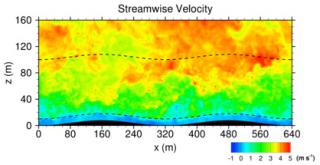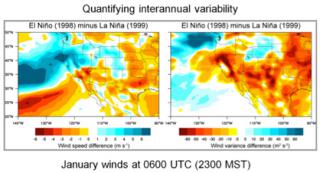NCAR's Contribution To Wind And Solar Energy Prediction
Relevant Experience
Specific Contributions
Background
Renewable energy decision makers are required to make critical judgments on a daily basis with regard to energy generation, distribution, demand, storage, and integration. Accurate knowledge of the present and future state of the atmosphere is vital in making these decisions.
Wind and solar energy are among the most difficult weather variables to forecast. Topography, surface roughness, ground cover, temperature inversions, foliage, gravity waves, low–level jets, clouds, and aerosols, all affect wind and solar energy prediction skill.
As wind and solar energy portfolios expand, this forecast problem is taking on new urgency because wind and solar energy forecast inaccuracies frequently lead to substantial economic losses and constrain the national expansion of renewable energy. Improved weather prediction and precise spatial analysis of small–scale weather events are crucial for energy management, as is the need to further develop and implement advanced technologies.
The National Center for Atmospheric Research (NCAR), a leader in atmospheric research, development and technology transfer for the past 50 years, is uniquely qualified to support the renewable energy industry in these endeavors. NCAR scientists are already actively engaged with industry decision makers on how best to foresee and respond to short and long–term changes in atmospheric conditions to mitigate risks associated with weather, particularly wind and solar energy prediction.
Relevant Experience
NCAR is a world–renowned atmospheric scientific research, development and technology transfer center which works to advance weather capabilities for mission agencies and the public and private sectors. NCAR is operated by the University Corporation for Atmospheric Research (UCAR), a non–profit organization established in 1960 to oversee a wide range of programs and facilities that support its 100+ university affiliates, as well as the national and international scientific community. As a national center, NCAR is able to utilize advancements developed not only at NCAR, but at research centers, institutes, universities, and national laboratories worldwide. NCAR is well–positioned to apply its expertise and technologies to support the renewable energy community and, through its technology transfer programs, to ensure that advancements are quickly adopted and utilized by industry.
Specific Contributions
Weather Prediction Modeling and Data Assimilation – NCAR is one of the lead organizations developing the Weather Research and Forecasting (WRF) model, as well as testing and distributing the code to the weather research and operational communities. WRF features multiple dynamical cores, a growing suite of data assimilation systems, and a software architecture allowing for computational parallelism and system extensibility. WRF is suitable for a broad spectrum of applications across scales ranging from meters to thousands of kilometers. NCAR's Joint Numerical Testbed (JNT) tests and evaluates numerical weather prediction systems to provide meaningful information about forecast performance to operational decision makers and to provide the research and development community (including NOAA and AFWA) with support in their development of these systems.
Data Assimilation – NCAR leads a large effort on data assimilation and has developed the WRF 3–Dimensional Variational Data Assimilation (3DVAR) system and a continuous Real–Time Four–Dimensional Data Assimilation (RTFDDA) system. NCAR has ported its RTFDDA assimilation technique to the WRF model, which is considered the best method of incorporating local observations into high–resolution models, such as those required for wind energy nowcasting and forecasting. The WRF RTFDDA allows for smooth and uninterrupted assimilation of new observations between forecast cycles (i.e., with no cold–starts that incur model spin–up effects in the first 6–12 hours of each forecast). The RTFDDA technology is part of the operational suite of weather systems NCAR has implemented for the U.S. Army's Test and Evaluation Command.
Wind Energy Nowcasting – UCAR has spent more than 15 years developing and operationally deploying a robust very short–term nowcasting system called the Auto–Nowcaster (image below). This system ingests available observational datasets (radar, surface station, satellite, lidar, met tower, and rawinsonde) in real–time, analyzes the atmosphere using physical models, combines observational data with weather model output, and generates nowcasts out to 2 hours every 6–10 minutes. Although initially designed to predict thunderstorm initiation, growth and decay, the methods and techniques used within this system are focused on the analysis and prediction of the lower boundary layer, and in particular, the local wind fields that are critical for wind energy nowcasting. These capabilities are uniquely suited for wind ramp and solar energy nowcasting.
Boundary Layer Research – NCAR has extensive expertise in planetary boundary layer (PBL) meteorology and modeling. NCAR research includes three–dimensional, time–dependent, PBL turbulence using turbulence–resolving numerical simulations and in particular Large–Eddy Simulation (LES) for a wide variety of geophysical flows. LES explicitly captures large turbulent eddies, which contain most of the turbulent kinetic energy and carry most of turbulent transport, and approximates the effects of small turbulent eddies in its subgrid–scale model. This technique was first developed at NCAR in the late 1960s, and is now widely used as a major tool for investigations of turbulence in engineering and geophysical fields. LES techniques are well suited for investigations of wind flow characterization, which is critical for the proper design and operation of wind turbines.
Evaluation of Global Wind and Solar Resources – NCAR's climate modeling and downscaling technologies are well positioned to support the development of wind and solar resource assessment datasets. In particular, the Climate Four Dimensional Data Assimilation System (CFDDA) has been used to create 25 years of global hourly climatologies with a 60 km grid size increment. This unique and large dataset was generated by NCAR with support by the Defense Threat Reduction Agenda (DTRA) and can be downscaled further to generate high–resolution physically balanced datasets that would provide critical information on the historical characteristics of the wind field at various wind generator hub heights. The global nature of these data makes them particularly useful for assessing the character of onshore and offshore wind resources. The wind energy industry would benefit from having access to these data.
Future Climate Impacts on Wind and Solar Resources – NCAR is a world leader in climate research and modeling and has been intimately involved in the work of the Intergovernmental Panel on Climate Change (IPCC). NCAR is also a key contributor to the North American Regional Climate Change Assessment Program (NARCCAP), which produces high–resolution climate change simulations in order to investigate uncertainties in regional scale projections of future climate and generate climate change scenarios for use in impacts research. This program has generated a full suite of regional climate projections at multiple scales that have been used to create climate change scenarios by end–users. These downscaled future climate data sets can be refined and reapplied to investigate future wind and solar energy resources across the nation.

Weather Education and Training – UCAR's award–winning Cooperative Meteorological Education and Training (COMET) program has developed dozens of computer–based user–tailored courses for meteorologists from the National Weather Service and the U.S military, as well as for students and other groups with varying expertise and backgrounds in weather. We see a unique opportunity for COMET and NREL to team to develop high–quality education and training materials for the wind and solar energy industry using COMET expertise and NREL subject matter experts. Envisioned is a series of interactive Web–based modules tailored to meteorologists and non–meteorologists in the renewable energy industry. Course topics could include: wind generator siting and prospecting, basics of boundary layer meteorology, low–level jets, terrain impacts on low–level wind flows, turbulence (and rotor wake turbulence), basics of wind forecasting, basics of solar radiation, wind and energy prediction, etc. The expanded knowledge gained from these courses would be used to improve wind generator design, optimize siting, enhance daily operations, and support wind and solar integration. The resulting web–based courses could be hosted on a UCAR or renewable energy industry (e.g., NREL or AWEA) web site and could provide education/training credits to participants.

Cloud and Solar Radiation Prediction – Although there has been a substantial, long–term effort by the weather research community to improve precipitation prediction, little attention has been paid to the prediction of clouds and insolation. The need for accurate insolation prediction is growing as the energy industry increases the percentage of distributed and concentrated solar energy. In addition, smart grid initiatives are expanding and the need for accurate forecasts of insolation (and temperature) is growing in parallel. NCAR's Joint Numerical Testbed (JNT) has a mission to test and verify the accuracy of weather models for NOAA and the research community. It is well positioned to assess the accuracy of operational and research models in predicting clouds and solar radiation. The results would highlight model skill and would provide valuable feedback to modelers on accuracy deficiencies. The results would be used to improve the models providing better information in the future to solar energy decision makers. NCAR is also tasked by the FAA to develop an aircraft contrail prediction system. Knowledge of the location of contrails and their longevity is important for solar energy generation as contrails can spread and persist for hours, significantly reducing the output of solar energy systems.

Turbine Icing – For more than 20 years, NCAR, with funding from the FAA and NASA, has led the nation in aircraft icing analysis and prediction. NCAR's aircraft icing products are disseminated to the aviation industry through NOAA's Aviation Weather Center. There are many similarities between aircraft icing and structure (wind turbine blade) icing because icing on wind turbines can dramatically affect their efficiency. Improved understanding of turbine icing is critical for the accurate prediction of wind energy. NCAR would welcome an opportunity to apply its icing expertise to the wind turbine–icing problem.
Experimental Design – Research experiments can be costly in terms of resources and computational effort. To help ensure projects reach robust conclusions, the statistical process of experimental design is used to help plan projects and subsequent data analysis. NCAR has extensive experience conducting Observing System Simulation Experiments (OSSEs) for a variety of sponsors who are interested in optimizing the configuration of weather sensor networks. These experiments significantly increase the likelihood that envisioned sensor networks will be designed and implemented to improve the skill of weather nowcasting and prediction systems.
NCAR Collaborations – NCAR has a long history of developing and maintaining strong collaborations with universities; the private sector; professional associations including the American Meteorological Society, American Wind Energy Association, Utility Wind Integration Group, American Geophysical Union, National Business Aviation Association, and the Intelligent Transportation Society of America; and with a host of federal agencies such as DOE, NOAA, DoD, DHS, NASA, USDOT, and NTSB. NCAR's ability to perform research, develop real–world solutions, and work with industry to bring the solutions to the marketplace to benefit the public make it an ideally suited to contribute to the advancement of renewable energy both nationally and internationally.
Contact
Please direct questions/comments about this page to:
Sue Ellen Haupt
Senior Scientist, Deputy Director Research Applications Laboratory

